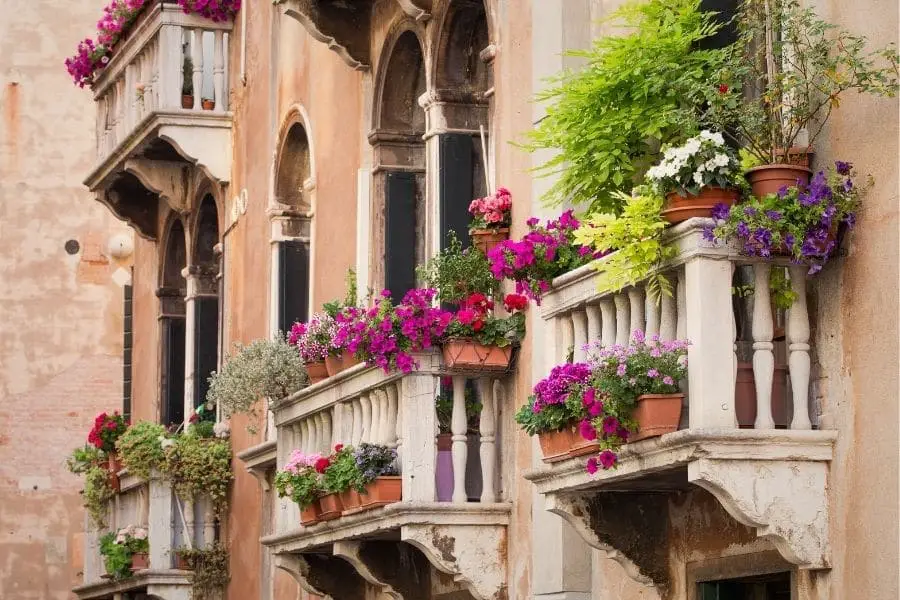Creating a terrace garden can transform your outdoor space into a green sanctuary, offering a serene escape from urban life. However, selecting the right plants for your terrace garden can be a challenging task. This guide will help you choose the best plants to ensure your garden thrives and adds beauty to your home.
Understanding Your Terrace Environment
Assessing Light Conditions
One of the most crucial factors in choosing the right plants for your terrace garden is understanding the light conditions. Terrace gardens can have varying levels of sunlight, from full sun to partial shade. Identify the areas that receive the most and least sunlight throughout the day.
- Full Sun: Areas that receive more than 6 hours of direct sunlight. Ideal for plants like roses, lavender, and succulents.
- Partial Shade: Areas that receive 3-6 hours of sunlight. Suitable for plants like ferns, begonias, and impatiens.
- Full Shade: Areas with less than 3 hours of direct sunlight. Best for plants like hostas, ivy, and ferns.
Considering Wind Exposure
Terraces, especially those on higher floors, can be exposed to strong winds. Choose wind-resistant plants like bamboo, junipers, and ornamental grasses. Additionally, using windbreaks like screens or trellises can protect more delicate plants.
Evaluating Temperature Fluctuations
Terraces can experience significant temperature fluctuations. Select plants that can withstand these variations. Perennials such as daylilies, black-eyed Susans, and coreopsis are known for their hardiness.
Choosing the Right Plants
Flowering Plants for Color and Fragrance
Flowering plants are essential for adding color and fragrance to your terrace garden. Consider the following options:
- Roses: Known for their beauty and fragrance, roses come in various colors and sizes.
- Lavender: Offers a pleasant aroma and purple blooms. It thrives in full sun and well-drained soil.
- Marigolds: Bright and cheerful, marigolds are easy to grow and deter pests.
Foliage Plants for Texture and Interest
Foliage plants add texture and visual interest to your garden. Some excellent choices include:
- Hostas: Known for their large, attractive leaves, hostas are perfect for shady areas.
- Ferns: Provide a lush, green backdrop and thrive in shaded conditions.
- Ornamental Grasses: Add movement and texture, suitable for sunny or partially shaded spots.
Edible Plants for a Functional Garden
Incorporating edible plants can make your terrace garden both beautiful and functional. Consider growing:
- Herbs: Basil, mint, and rosemary are easy to grow and perfect for cooking.
- Vegetables: Tomatoes, peppers, and lettuce can thrive in containers.
- Fruits: Strawberries and dwarf citrus trees can add a sweet touch.
Succulents for Low Maintenance
If you prefer low-maintenance options, succulents are ideal. They are drought-tolerant and come in various shapes and sizes. Popular choices include:
- Aloe Vera: Known for its medicinal properties.
- Sedum: Available in many varieties, perfect for ground cover.
- Echeveria: Attractive rosettes that come in different colors.
Planting and Maintenance Tips
Soil and Containers
Use high-quality potting soil for your terrace garden. Ensure good drainage by choosing containers with drainage holes. Terracotta pots are excellent for most plants as they allow air and moisture to pass through.
Watering Practices
Watering needs vary depending on the plant type and weather conditions. Generally, it’s best to water in the early morning or late afternoon to minimize evaporation. Use a drip irrigation system for consistent and efficient watering.
Fertilizing
Regular fertilization promotes healthy growth. Use organic fertilizers like compost or fish emulsion. Follow the recommended feeding schedule for each plant type.
Pest Control
Monitor your plants regularly for pests. Use organic pest control methods like neem oil or introduce beneficial insects like ladybugs. Avoid chemical pesticides as they can harm beneficial insects and the environment.
Pruning and Deadheading
Pruning helps maintain plant shape and encourages new growth. Deadheading, or removing spent flowers, promotes further blooming. Use clean, sharp tools to prevent disease spread.
Designing Your Terrace Garden
Vertical Gardening
Maximize your space with vertical gardening techniques. Use trellises, wall planters, and hanging baskets to grow climbing plants like ivy, jasmine, and morning glories.
Companion Planting
Pair plants that benefit each other. For example, growing basil alongside tomatoes can enhance flavor and deter pests. Companion planting can improve plant health and productivity.
Creating Focal Points
Design your garden with focal points to draw the eye. Use larger plants or decorative elements like a garden statue, water feature, or a striking container to create visual interest.
Seasonal Planting
Plan your garden to have something blooming throughout the year. Use a mix of annuals and perennials to ensure continuous color and interest. For example, plant tulips and daffodils for spring, sunflowers and marigolds for summer, and chrysanthemums and pansies for fall.
Conclusion
Choosing the best plants for your terrace garden requires careful consideration of your environment, plant characteristics, and maintenance requirements. By selecting a mix of flowering, foliage, edible, and low-maintenance plants, you can create a vibrant and thriving garden that enhances your outdoor space.


